Environmental Management Systems in the Australian Agriculture Sector
VerifiedAdded on 2023/06/05
|7
|2240
|355
Essay
AI Summary
This essay discusses the Environmental Management System (EMS) in the Australian agricultural sector, focusing on its implementation, adoption, and limitations. Supported and regulated by the Australian government, EMS aims to promote sustainable food production and minimize environmental impact. The essay highlights the key objectives of EMS, including natural resource management, competitiveness, and social responsibility. It also examines the role of ISO 14001:2015 and ISO 14040:2006 standards in guiding EMS implementation. The challenges and issues associated with EMS adoption, such as the process-based nature, institutional pressures, and lack of participation, are addressed, along with potential solutions. Furthermore, the essay explores the adoption of EMS in various agricultural industries and the importance of overcoming limitations through initiatives like the National Framework. The conclusion emphasizes the cooperative support and strategic partnerships fostered by EMS, contributing to a sustainable rural future.
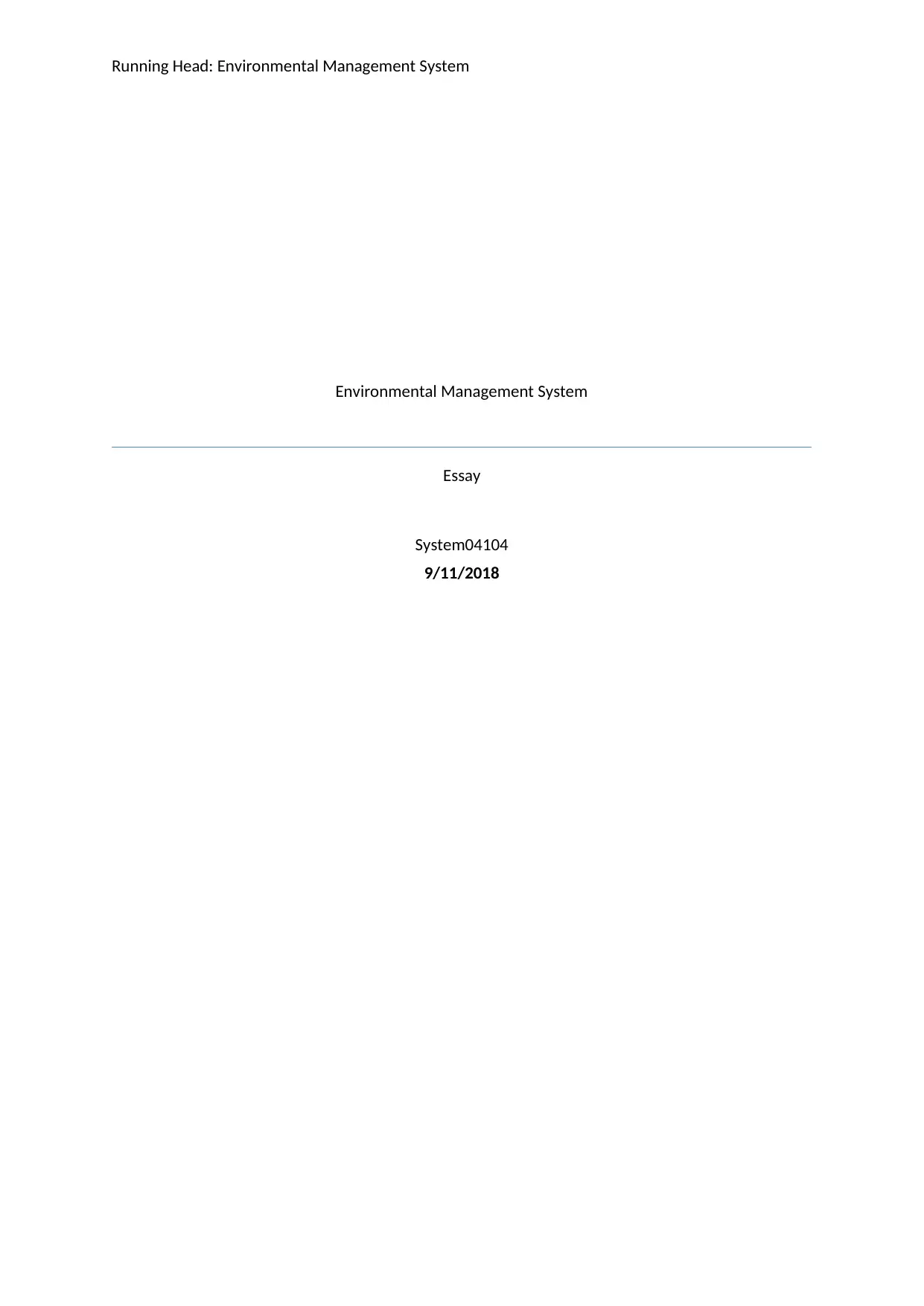
Running Head: Environmental Management System
Environmental Management System
Essay
System04104
9/11/2018
Environmental Management System
Essay
System04104
9/11/2018
Paraphrase This Document
Need a fresh take? Get an instant paraphrase of this document with our AI Paraphraser
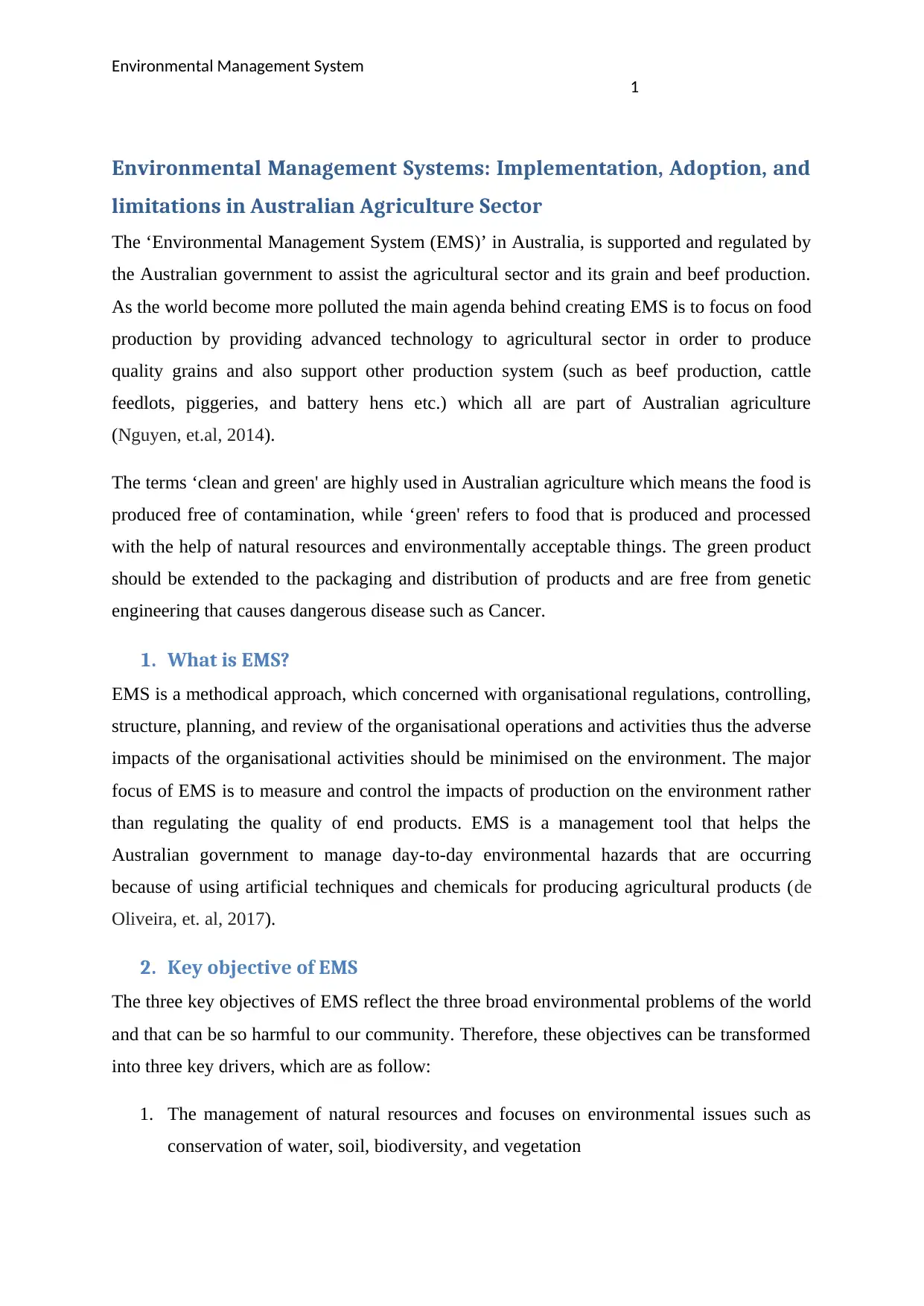
Environmental Management System
1
Environmental Management Systems: Implementation, Adoption, and
limitations in Australian Agriculture Sector
The ‘Environmental Management System (EMS)’ in Australia, is supported and regulated by
the Australian government to assist the agricultural sector and its grain and beef production.
As the world become more polluted the main agenda behind creating EMS is to focus on food
production by providing advanced technology to agricultural sector in order to produce
quality grains and also support other production system (such as beef production, cattle
feedlots, piggeries, and battery hens etc.) which all are part of Australian agriculture
(Nguyen, et.al, 2014).
The terms ‘clean and green' are highly used in Australian agriculture which means the food is
produced free of contamination, while ‘green' refers to food that is produced and processed
with the help of natural resources and environmentally acceptable things. The green product
should be extended to the packaging and distribution of products and are free from genetic
engineering that causes dangerous disease such as Cancer.
1. What is EMS?
EMS is a methodical approach, which concerned with organisational regulations, controlling,
structure, planning, and review of the organisational operations and activities thus the adverse
impacts of the organisational activities should be minimised on the environment. The major
focus of EMS is to measure and control the impacts of production on the environment rather
than regulating the quality of end products. EMS is a management tool that helps the
Australian government to manage day-to-day environmental hazards that are occurring
because of using artificial techniques and chemicals for producing agricultural products (de
Oliveira, et. al, 2017).
2. Key objective of EMS
The three key objectives of EMS reflect the three broad environmental problems of the world
and that can be so harmful to our community. Therefore, these objectives can be transformed
into three key drivers, which are as follow:
1. The management of natural resources and focuses on environmental issues such as
conservation of water, soil, biodiversity, and vegetation
1
Environmental Management Systems: Implementation, Adoption, and
limitations in Australian Agriculture Sector
The ‘Environmental Management System (EMS)’ in Australia, is supported and regulated by
the Australian government to assist the agricultural sector and its grain and beef production.
As the world become more polluted the main agenda behind creating EMS is to focus on food
production by providing advanced technology to agricultural sector in order to produce
quality grains and also support other production system (such as beef production, cattle
feedlots, piggeries, and battery hens etc.) which all are part of Australian agriculture
(Nguyen, et.al, 2014).
The terms ‘clean and green' are highly used in Australian agriculture which means the food is
produced free of contamination, while ‘green' refers to food that is produced and processed
with the help of natural resources and environmentally acceptable things. The green product
should be extended to the packaging and distribution of products and are free from genetic
engineering that causes dangerous disease such as Cancer.
1. What is EMS?
EMS is a methodical approach, which concerned with organisational regulations, controlling,
structure, planning, and review of the organisational operations and activities thus the adverse
impacts of the organisational activities should be minimised on the environment. The major
focus of EMS is to measure and control the impacts of production on the environment rather
than regulating the quality of end products. EMS is a management tool that helps the
Australian government to manage day-to-day environmental hazards that are occurring
because of using artificial techniques and chemicals for producing agricultural products (de
Oliveira, et. al, 2017).
2. Key objective of EMS
The three key objectives of EMS reflect the three broad environmental problems of the world
and that can be so harmful to our community. Therefore, these objectives can be transformed
into three key drivers, which are as follow:
1. The management of natural resources and focuses on environmental issues such as
conservation of water, soil, biodiversity, and vegetation
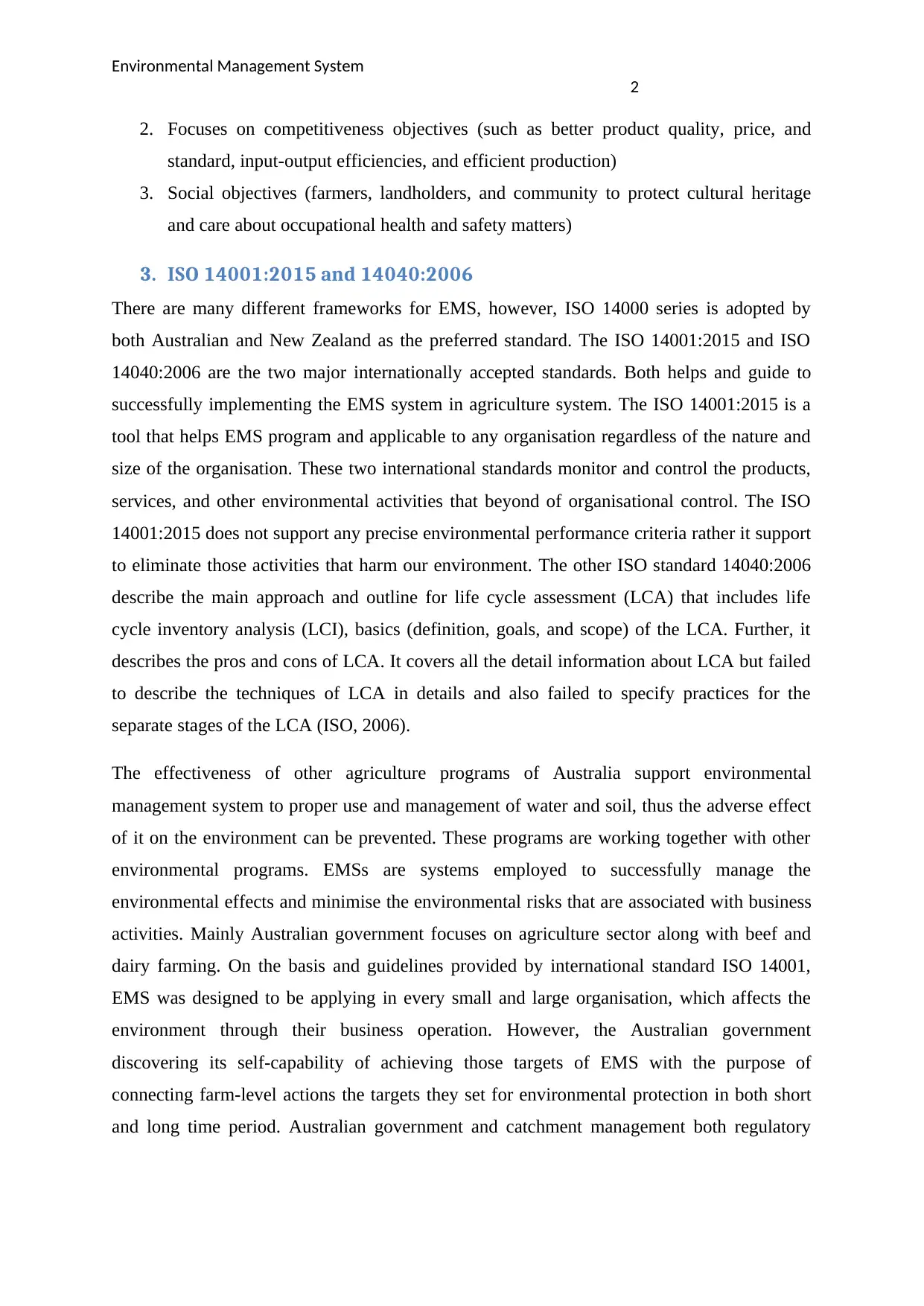
Environmental Management System
2
2. Focuses on competitiveness objectives (such as better product quality, price, and
standard, input-output efficiencies, and efficient production)
3. Social objectives (farmers, landholders, and community to protect cultural heritage
and care about occupational health and safety matters)
3. ISO 14001:2015 and 14040:2006
There are many different frameworks for EMS, however, ISO 14000 series is adopted by
both Australian and New Zealand as the preferred standard. The ISO 14001:2015 and ISO
14040:2006 are the two major internationally accepted standards. Both helps and guide to
successfully implementing the EMS system in agriculture system. The ISO 14001:2015 is a
tool that helps EMS program and applicable to any organisation regardless of the nature and
size of the organisation. These two international standards monitor and control the products,
services, and other environmental activities that beyond of organisational control. The ISO
14001:2015 does not support any precise environmental performance criteria rather it support
to eliminate those activities that harm our environment. The other ISO standard 14040:2006
describe the main approach and outline for life cycle assessment (LCA) that includes life
cycle inventory analysis (LCI), basics (definition, goals, and scope) of the LCA. Further, it
describes the pros and cons of LCA. It covers all the detail information about LCA but failed
to describe the techniques of LCA in details and also failed to specify practices for the
separate stages of the LCA (ISO, 2006).
The effectiveness of other agriculture programs of Australia support environmental
management system to proper use and management of water and soil, thus the adverse effect
of it on the environment can be prevented. These programs are working together with other
environmental programs. EMSs are systems employed to successfully manage the
environmental effects and minimise the environmental risks that are associated with business
activities. Mainly Australian government focuses on agriculture sector along with beef and
dairy farming. On the basis and guidelines provided by international standard ISO 14001,
EMS was designed to be applying in every small and large organisation, which affects the
environment through their business operation. However, the Australian government
discovering its self-capability of achieving those targets of EMS with the purpose of
connecting farm-level actions the targets they set for environmental protection in both short
and long time period. Australian government and catchment management both regulatory
2
2. Focuses on competitiveness objectives (such as better product quality, price, and
standard, input-output efficiencies, and efficient production)
3. Social objectives (farmers, landholders, and community to protect cultural heritage
and care about occupational health and safety matters)
3. ISO 14001:2015 and 14040:2006
There are many different frameworks for EMS, however, ISO 14000 series is adopted by
both Australian and New Zealand as the preferred standard. The ISO 14001:2015 and ISO
14040:2006 are the two major internationally accepted standards. Both helps and guide to
successfully implementing the EMS system in agriculture system. The ISO 14001:2015 is a
tool that helps EMS program and applicable to any organisation regardless of the nature and
size of the organisation. These two international standards monitor and control the products,
services, and other environmental activities that beyond of organisational control. The ISO
14001:2015 does not support any precise environmental performance criteria rather it support
to eliminate those activities that harm our environment. The other ISO standard 14040:2006
describe the main approach and outline for life cycle assessment (LCA) that includes life
cycle inventory analysis (LCI), basics (definition, goals, and scope) of the LCA. Further, it
describes the pros and cons of LCA. It covers all the detail information about LCA but failed
to describe the techniques of LCA in details and also failed to specify practices for the
separate stages of the LCA (ISO, 2006).
The effectiveness of other agriculture programs of Australia support environmental
management system to proper use and management of water and soil, thus the adverse effect
of it on the environment can be prevented. These programs are working together with other
environmental programs. EMSs are systems employed to successfully manage the
environmental effects and minimise the environmental risks that are associated with business
activities. Mainly Australian government focuses on agriculture sector along with beef and
dairy farming. On the basis and guidelines provided by international standard ISO 14001,
EMS was designed to be applying in every small and large organisation, which affects the
environment through their business operation. However, the Australian government
discovering its self-capability of achieving those targets of EMS with the purpose of
connecting farm-level actions the targets they set for environmental protection in both short
and long time period. Australian government and catchment management both regulatory
⊘ This is a preview!⊘
Do you want full access?
Subscribe today to unlock all pages.

Trusted by 1+ million students worldwide
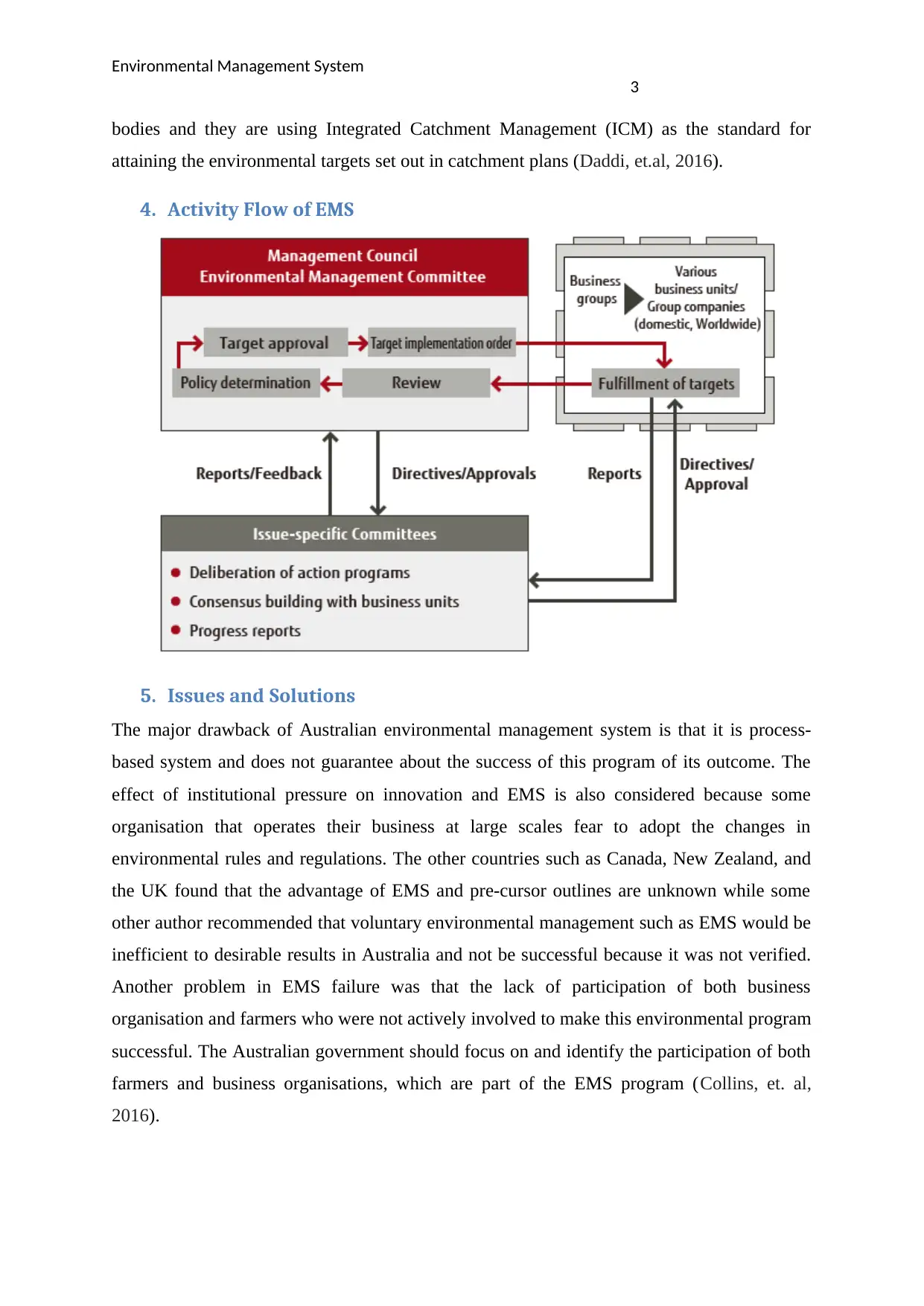
Environmental Management System
3
bodies and they are using Integrated Catchment Management (ICM) as the standard for
attaining the environmental targets set out in catchment plans (Daddi, et.al, 2016).
4. Activity Flow of EMS
5. Issues and Solutions
The major drawback of Australian environmental management system is that it is process-
based system and does not guarantee about the success of this program of its outcome. The
effect of institutional pressure on innovation and EMS is also considered because some
organisation that operates their business at large scales fear to adopt the changes in
environmental rules and regulations. The other countries such as Canada, New Zealand, and
the UK found that the advantage of EMS and pre-cursor outlines are unknown while some
other author recommended that voluntary environmental management such as EMS would be
inefficient to desirable results in Australia and not be successful because it was not verified.
Another problem in EMS failure was that the lack of participation of both business
organisation and farmers who were not actively involved to make this environmental program
successful. The Australian government should focus on and identify the participation of both
farmers and business organisations, which are part of the EMS program (Collins, et. al,
2016).
3
bodies and they are using Integrated Catchment Management (ICM) as the standard for
attaining the environmental targets set out in catchment plans (Daddi, et.al, 2016).
4. Activity Flow of EMS
5. Issues and Solutions
The major drawback of Australian environmental management system is that it is process-
based system and does not guarantee about the success of this program of its outcome. The
effect of institutional pressure on innovation and EMS is also considered because some
organisation that operates their business at large scales fear to adopt the changes in
environmental rules and regulations. The other countries such as Canada, New Zealand, and
the UK found that the advantage of EMS and pre-cursor outlines are unknown while some
other author recommended that voluntary environmental management such as EMS would be
inefficient to desirable results in Australia and not be successful because it was not verified.
Another problem in EMS failure was that the lack of participation of both business
organisation and farmers who were not actively involved to make this environmental program
successful. The Australian government should focus on and identify the participation of both
farmers and business organisations, which are part of the EMS program (Collins, et. al,
2016).
Paraphrase This Document
Need a fresh take? Get an instant paraphrase of this document with our AI Paraphraser
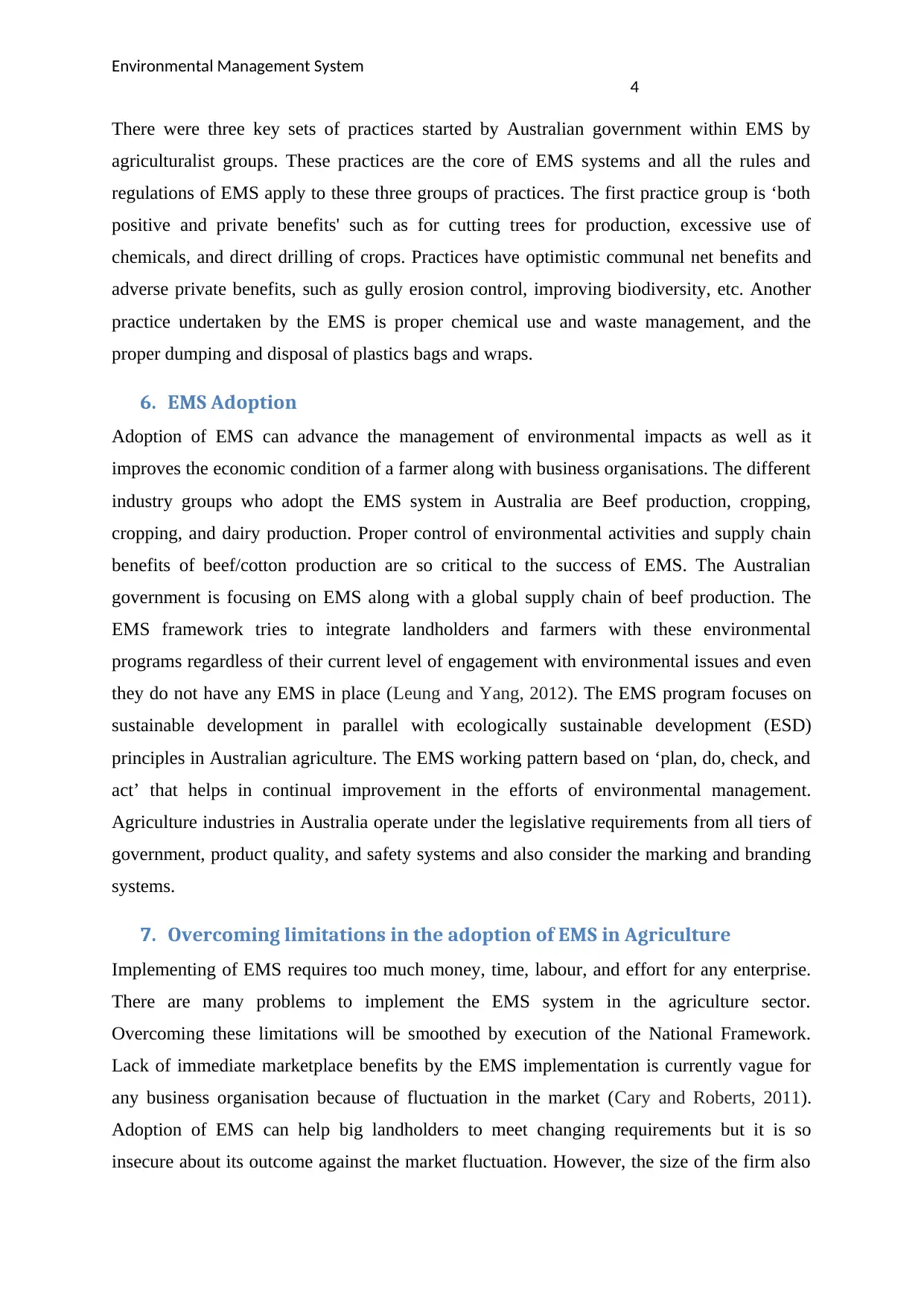
Environmental Management System
4
There were three key sets of practices started by Australian government within EMS by
agriculturalist groups. These practices are the core of EMS systems and all the rules and
regulations of EMS apply to these three groups of practices. The first practice group is ‘both
positive and private benefits' such as for cutting trees for production, excessive use of
chemicals, and direct drilling of crops. Practices have optimistic communal net benefits and
adverse private benefits, such as gully erosion control, improving biodiversity, etc. Another
practice undertaken by the EMS is proper chemical use and waste management, and the
proper dumping and disposal of plastics bags and wraps.
6. EMS Adoption
Adoption of EMS can advance the management of environmental impacts as well as it
improves the economic condition of a farmer along with business organisations. The different
industry groups who adopt the EMS system in Australia are Beef production, cropping,
cropping, and dairy production. Proper control of environmental activities and supply chain
benefits of beef/cotton production are so critical to the success of EMS. The Australian
government is focusing on EMS along with a global supply chain of beef production. The
EMS framework tries to integrate landholders and farmers with these environmental
programs regardless of their current level of engagement with environmental issues and even
they do not have any EMS in place (Leung and Yang, 2012). The EMS program focuses on
sustainable development in parallel with ecologically sustainable development (ESD)
principles in Australian agriculture. The EMS working pattern based on ‘plan, do, check, and
act’ that helps in continual improvement in the efforts of environmental management.
Agriculture industries in Australia operate under the legislative requirements from all tiers of
government, product quality, and safety systems and also consider the marking and branding
systems.
7. Overcoming limitations in the adoption of EMS in Agriculture
Implementing of EMS requires too much money, time, labour, and effort for any enterprise.
There are many problems to implement the EMS system in the agriculture sector.
Overcoming these limitations will be smoothed by execution of the National Framework.
Lack of immediate marketplace benefits by the EMS implementation is currently vague for
any business organisation because of fluctuation in the market (Cary and Roberts, 2011).
Adoption of EMS can help big landholders to meet changing requirements but it is so
insecure about its outcome against the market fluctuation. However, the size of the firm also
4
There were three key sets of practices started by Australian government within EMS by
agriculturalist groups. These practices are the core of EMS systems and all the rules and
regulations of EMS apply to these three groups of practices. The first practice group is ‘both
positive and private benefits' such as for cutting trees for production, excessive use of
chemicals, and direct drilling of crops. Practices have optimistic communal net benefits and
adverse private benefits, such as gully erosion control, improving biodiversity, etc. Another
practice undertaken by the EMS is proper chemical use and waste management, and the
proper dumping and disposal of plastics bags and wraps.
6. EMS Adoption
Adoption of EMS can advance the management of environmental impacts as well as it
improves the economic condition of a farmer along with business organisations. The different
industry groups who adopt the EMS system in Australia are Beef production, cropping,
cropping, and dairy production. Proper control of environmental activities and supply chain
benefits of beef/cotton production are so critical to the success of EMS. The Australian
government is focusing on EMS along with a global supply chain of beef production. The
EMS framework tries to integrate landholders and farmers with these environmental
programs regardless of their current level of engagement with environmental issues and even
they do not have any EMS in place (Leung and Yang, 2012). The EMS program focuses on
sustainable development in parallel with ecologically sustainable development (ESD)
principles in Australian agriculture. The EMS working pattern based on ‘plan, do, check, and
act’ that helps in continual improvement in the efforts of environmental management.
Agriculture industries in Australia operate under the legislative requirements from all tiers of
government, product quality, and safety systems and also consider the marking and branding
systems.
7. Overcoming limitations in the adoption of EMS in Agriculture
Implementing of EMS requires too much money, time, labour, and effort for any enterprise.
There are many problems to implement the EMS system in the agriculture sector.
Overcoming these limitations will be smoothed by execution of the National Framework.
Lack of immediate marketplace benefits by the EMS implementation is currently vague for
any business organisation because of fluctuation in the market (Cary and Roberts, 2011).
Adoption of EMS can help big landholders to meet changing requirements but it is so
insecure about its outcome against the market fluctuation. However, the size of the firm also
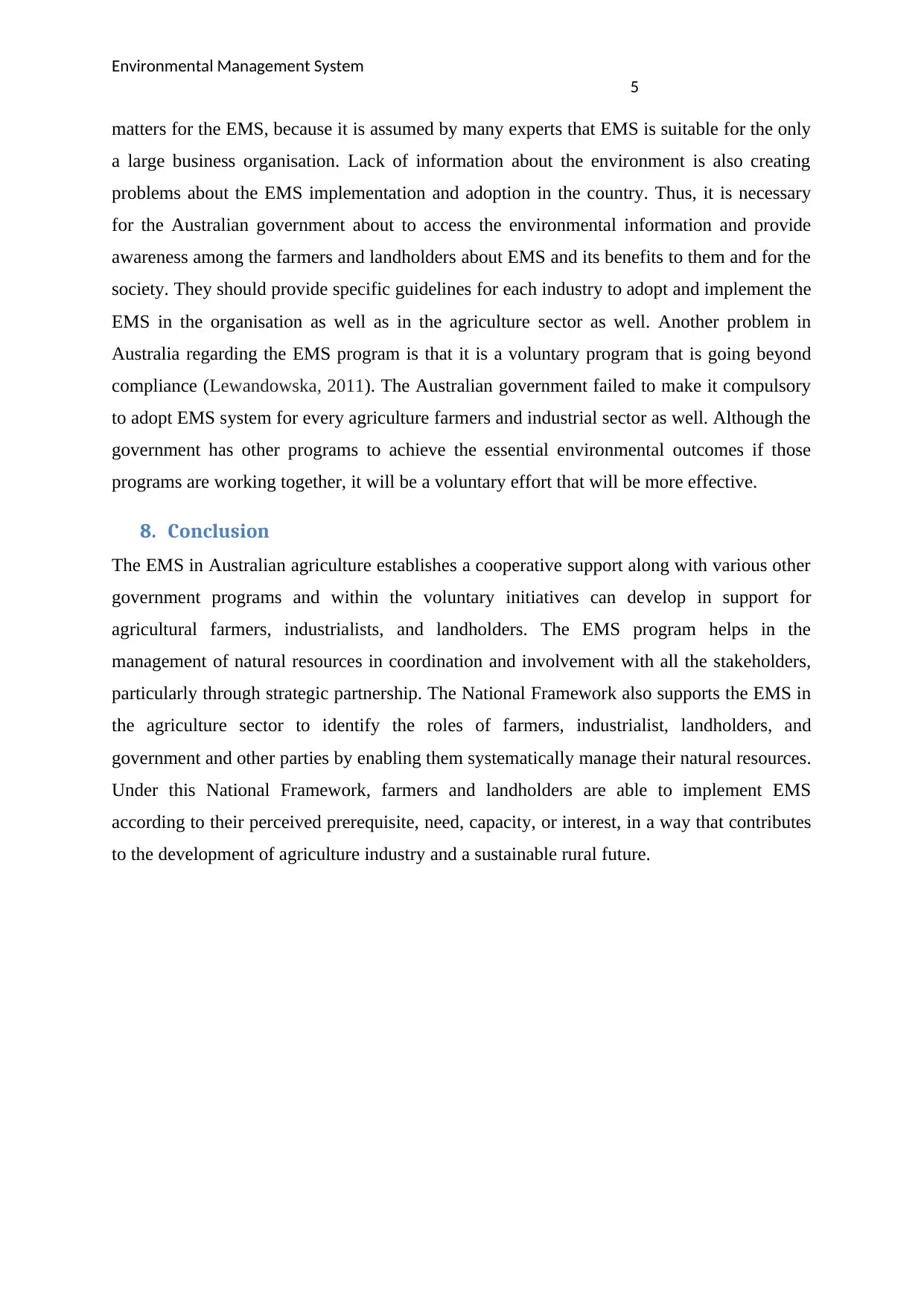
Environmental Management System
5
matters for the EMS, because it is assumed by many experts that EMS is suitable for the only
a large business organisation. Lack of information about the environment is also creating
problems about the EMS implementation and adoption in the country. Thus, it is necessary
for the Australian government about to access the environmental information and provide
awareness among the farmers and landholders about EMS and its benefits to them and for the
society. They should provide specific guidelines for each industry to adopt and implement the
EMS in the organisation as well as in the agriculture sector as well. Another problem in
Australia regarding the EMS program is that it is a voluntary program that is going beyond
compliance (Lewandowska, 2011). The Australian government failed to make it compulsory
to adopt EMS system for every agriculture farmers and industrial sector as well. Although the
government has other programs to achieve the essential environmental outcomes if those
programs are working together, it will be a voluntary effort that will be more effective.
8. Conclusion
The EMS in Australian agriculture establishes a cooperative support along with various other
government programs and within the voluntary initiatives can develop in support for
agricultural farmers, industrialists, and landholders. The EMS program helps in the
management of natural resources in coordination and involvement with all the stakeholders,
particularly through strategic partnership. The National Framework also supports the EMS in
the agriculture sector to identify the roles of farmers, industrialist, landholders, and
government and other parties by enabling them systematically manage their natural resources.
Under this National Framework, farmers and landholders are able to implement EMS
according to their perceived prerequisite, need, capacity, or interest, in a way that contributes
to the development of agriculture industry and a sustainable rural future.
5
matters for the EMS, because it is assumed by many experts that EMS is suitable for the only
a large business organisation. Lack of information about the environment is also creating
problems about the EMS implementation and adoption in the country. Thus, it is necessary
for the Australian government about to access the environmental information and provide
awareness among the farmers and landholders about EMS and its benefits to them and for the
society. They should provide specific guidelines for each industry to adopt and implement the
EMS in the organisation as well as in the agriculture sector as well. Another problem in
Australia regarding the EMS program is that it is a voluntary program that is going beyond
compliance (Lewandowska, 2011). The Australian government failed to make it compulsory
to adopt EMS system for every agriculture farmers and industrial sector as well. Although the
government has other programs to achieve the essential environmental outcomes if those
programs are working together, it will be a voluntary effort that will be more effective.
8. Conclusion
The EMS in Australian agriculture establishes a cooperative support along with various other
government programs and within the voluntary initiatives can develop in support for
agricultural farmers, industrialists, and landholders. The EMS program helps in the
management of natural resources in coordination and involvement with all the stakeholders,
particularly through strategic partnership. The National Framework also supports the EMS in
the agriculture sector to identify the roles of farmers, industrialist, landholders, and
government and other parties by enabling them systematically manage their natural resources.
Under this National Framework, farmers and landholders are able to implement EMS
according to their perceived prerequisite, need, capacity, or interest, in a way that contributes
to the development of agriculture industry and a sustainable rural future.
⊘ This is a preview!⊘
Do you want full access?
Subscribe today to unlock all pages.

Trusted by 1+ million students worldwide
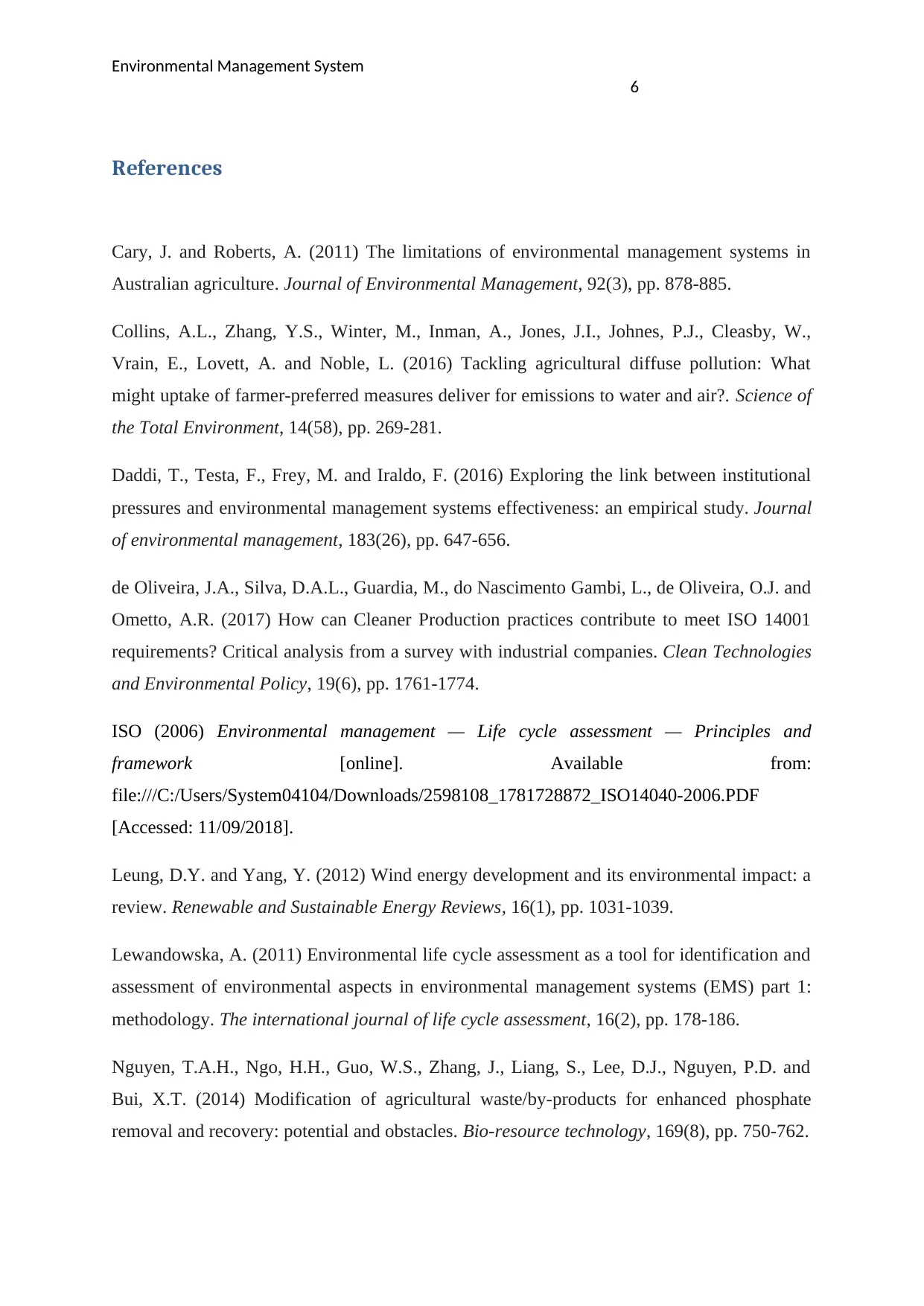
Environmental Management System
6
References
Cary, J. and Roberts, A. (2011) The limitations of environmental management systems in
Australian agriculture. Journal of Environmental Management, 92(3), pp. 878-885.
Collins, A.L., Zhang, Y.S., Winter, M., Inman, A., Jones, J.I., Johnes, P.J., Cleasby, W.,
Vrain, E., Lovett, A. and Noble, L. (2016) Tackling agricultural diffuse pollution: What
might uptake of farmer-preferred measures deliver for emissions to water and air?. Science of
the Total Environment, 14(58), pp. 269-281.
Daddi, T., Testa, F., Frey, M. and Iraldo, F. (2016) Exploring the link between institutional
pressures and environmental management systems effectiveness: an empirical study. Journal
of environmental management, 183(26), pp. 647-656.
de Oliveira, J.A., Silva, D.A.L., Guardia, M., do Nascimento Gambi, L., de Oliveira, O.J. and
Ometto, A.R. (2017) How can Cleaner Production practices contribute to meet ISO 14001
requirements? Critical analysis from a survey with industrial companies. Clean Technologies
and Environmental Policy, 19(6), pp. 1761-1774.
ISO (2006) Environmental management — Life cycle assessment — Principles and
framework [online]. Available from:
file:///C:/Users/System04104/Downloads/2598108_1781728872_ISO14040-2006.PDF
[Accessed: 11/09/2018].
Leung, D.Y. and Yang, Y. (2012) Wind energy development and its environmental impact: a
review. Renewable and Sustainable Energy Reviews, 16(1), pp. 1031-1039.
Lewandowska, A. (2011) Environmental life cycle assessment as a tool for identification and
assessment of environmental aspects in environmental management systems (EMS) part 1:
methodology. The international journal of life cycle assessment, 16(2), pp. 178-186.
Nguyen, T.A.H., Ngo, H.H., Guo, W.S., Zhang, J., Liang, S., Lee, D.J., Nguyen, P.D. and
Bui, X.T. (2014) Modification of agricultural waste/by-products for enhanced phosphate
removal and recovery: potential and obstacles. Bio-resource technology, 169(8), pp. 750-762.
6
References
Cary, J. and Roberts, A. (2011) The limitations of environmental management systems in
Australian agriculture. Journal of Environmental Management, 92(3), pp. 878-885.
Collins, A.L., Zhang, Y.S., Winter, M., Inman, A., Jones, J.I., Johnes, P.J., Cleasby, W.,
Vrain, E., Lovett, A. and Noble, L. (2016) Tackling agricultural diffuse pollution: What
might uptake of farmer-preferred measures deliver for emissions to water and air?. Science of
the Total Environment, 14(58), pp. 269-281.
Daddi, T., Testa, F., Frey, M. and Iraldo, F. (2016) Exploring the link between institutional
pressures and environmental management systems effectiveness: an empirical study. Journal
of environmental management, 183(26), pp. 647-656.
de Oliveira, J.A., Silva, D.A.L., Guardia, M., do Nascimento Gambi, L., de Oliveira, O.J. and
Ometto, A.R. (2017) How can Cleaner Production practices contribute to meet ISO 14001
requirements? Critical analysis from a survey with industrial companies. Clean Technologies
and Environmental Policy, 19(6), pp. 1761-1774.
ISO (2006) Environmental management — Life cycle assessment — Principles and
framework [online]. Available from:
file:///C:/Users/System04104/Downloads/2598108_1781728872_ISO14040-2006.PDF
[Accessed: 11/09/2018].
Leung, D.Y. and Yang, Y. (2012) Wind energy development and its environmental impact: a
review. Renewable and Sustainable Energy Reviews, 16(1), pp. 1031-1039.
Lewandowska, A. (2011) Environmental life cycle assessment as a tool for identification and
assessment of environmental aspects in environmental management systems (EMS) part 1:
methodology. The international journal of life cycle assessment, 16(2), pp. 178-186.
Nguyen, T.A.H., Ngo, H.H., Guo, W.S., Zhang, J., Liang, S., Lee, D.J., Nguyen, P.D. and
Bui, X.T. (2014) Modification of agricultural waste/by-products for enhanced phosphate
removal and recovery: potential and obstacles. Bio-resource technology, 169(8), pp. 750-762.
1 out of 7
Related Documents
Your All-in-One AI-Powered Toolkit for Academic Success.
+13062052269
info@desklib.com
Available 24*7 on WhatsApp / Email
![[object Object]](/_next/static/media/star-bottom.7253800d.svg)
Unlock your academic potential
Copyright © 2020–2025 A2Z Services. All Rights Reserved. Developed and managed by ZUCOL.




